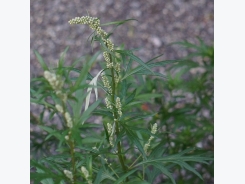How to Grow Spiderwort

Spiderwort (Tradescantia) is a charming, old-fashioned plant that should be grown more often than it is.
The plant is native to woodland areas and thrives in moist, humus-rich soil. It blooms best in partial shade, although it grows in full sun as long as the soil is moist.
Spiderwort grows 1 to 3 feet tall, with long, strap-like foliage, similar to daylilies. It produces lovely, simple flowers in blue, violet, pink or crimson. The blooms appear in the morning and last only one day, closing by late afternoon. Blooms appear in early-to-mid summer; bloom time is 4 to 6 weeks.
How did this beautiful plant come by its name? There are several theories. The sap from the plant was known as a remedy for spider bites. The dangling flowers may resemble spiders to some. Also, the sepals of the flowers are covered with glistening hairs, which resemble spider webs, especially when covered with dew. Take your pick.
Spiderwort Propagation
The simplest way to propagate spiderwort is by using nursery plants or taking a plant from a friend. Spiderwort spreads quickly through underground runners so once you have an established plant, you can get many more through divisions.
You can also grow spiderwort from seed. Plant the seed outdoors in the fall. Prepare the soil by digging compost or manure into it to a depth of 8 inches. Rake the soil so it’s even and plant the seeds 1/8 inch deep.
If you want to start seeds indoors, you’ll need to provide a cold period to break dormancy. Mix sand and perlite in a plastic bag. Add 1 tablespoon hot water and mix thoroughly. Mix the seeds with the sand mixture and store in the refrigerator for up to 4 months. Remove the bag from the refrigerator 8 weeks before the last frost. Fill a seed-starting tray with a starter mix. Spread the sand mixture evenly over the starter mix. Spray the seed tray with water from a spray bottle and cover it with plastic wrap. Place the tray in a warm location and spray it as needed to keep the mixture evenly moist. Once the seedlings emerge, remove the plastic wrap and move the tray to a sunny window or place it under grow lights. Continue to water as needed. Transplant the seedlings outdoors when they stand 4 inches high.
Growing Spiderwort
There isn’t much to growing spiderwort. It prefers moist but not soggy soil. Apply a balanced fertilizer in the spring before new growth emerges, but don’t overfertilize spiderwort, which causes weak, spindly growth and few blooms.
Once established, spiderwort spreads rapidly. It can become invasive if planted in a mixed bed. Give it its own space, if possible, and divide it every 3 or 4 years to keep it under control. In mid-summer, the plant sometimes becomes messy and unruly. Cut it back after it blooms to keep it tidy and encourage another round of flowering.
Spiderwort can also be grown indoors or in containers if you lack garden space. Grow it by itself in a large container near a bright, sunny window.
The plant has few insect or disease problems, although it may occasionally be infected with rust or powdery mildew. Space spiderwort so air circulates freely and avoid getting the leaves wet to prevent most problems. Cats and dogs like to play in it and sheep and deer may graze on it.
Varieties of Spiderwort
‘Zwanenberg' is a traditional spiderwort with very large, blue to deep-purple flowers.
‘Sweet Kate’ is an interesting variety with purple-blue flowers and yellow leaves.
‘Red Cloud’ grows 20 inches high with deep crimson blooms.
‘Snow Cap’ has pure white blooms.
‘Satin Doll’ is a compact variety suitable for container culture. It has pink flowers.
Có thể bạn quan tâm
Phần mềm

Phối trộn thức ăn chăn nuôi

Pha dung dịch thủy canh

Định mức cho tôm ăn

Phối trộn phân bón NPK

Xác định tỷ lệ tôm sống

Chuyển đổi đơn vị phân bón

Xác định công suất sục khí

Chuyển đổi đơn vị tôm

Tính diện tích nhà kính

Tính thể tích ao hồ



 How to Grow Melampodium (Butter Daisy)
How to Grow Melampodium (Butter Daisy)  How to Grow Johnny Jump Up
How to Grow Johnny Jump Up